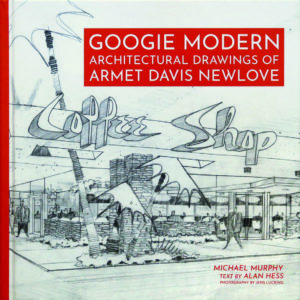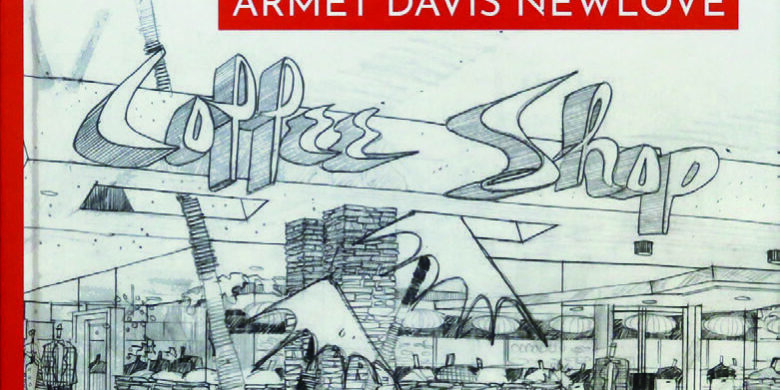GOOGIE MODERN: Architectural Drawings of Armet Davis Newlove
By Michael Murphy
With Text by Alan Hess and Photography by Jens Lucking
Angel City Press, 2022
Hardcover, 206 pages, Retail: $50
Reviewed by Heather David
 My first encounter with the offices of Armet Davis Newlove Architects (ADN) was in 2007 when putting together an educational website to celebrate local mid-century modern architecture. I had my sights on an illustration of Bob’s Big Boy in San Jose, California, on a website called “GOOGIE ART,” which showcased many of the firm’s architectural renderings.
My first encounter with the offices of Armet Davis Newlove Architects (ADN) was in 2007 when putting together an educational website to celebrate local mid-century modern architecture. I had my sights on an illustration of Bob’s Big Boy in San Jose, California, on a website called “GOOGIE ART,” which showcased many of the firm’s architectural renderings.
ADN was a California architectural firm formed by Louis Armét and Eldon Davis in 1947, which added Victor Newlove in 1963. Newlove became a partner in 1972, changing the firm’s name to Armet Davis Newlove Architects.
I emailed Newlove to see if I could use the image. Within minutes, I received a return message with an “OK” and “no fee for the use of images.” I could not believe my good fortune—and Mr. Newlove’s kindness. This correspondence began many shameless pleas for assistance with assorted self-funded projects.
In 2016, while putting the final touches on my book Motel California, I visited the offices of Armet Davis Newlove in Santa Monica and got to dig through their project archives. It was indeed a “kid in the candy store” experience. I could have spent DAYS in that file room. I wasn’t, however, the first to encounter this treasure trove. The firm has helped preservationists and historians with countless projects over the years, from books and academic presentations to museum and gallery exhibits.
The thing is, decades of history remained in a private collection.
This introduction leads us to the new book GOOGIE MODERN: Architectural Drawings of Armet Davis and Newlove by Michael Murphy. But first, let us define “Googie.”
 The term “Googie,” as a subset of mid-century modern architecture, can be traced back to an article that first appeared in House and Home magazine in February 1952. The editor of Architectural Forum, Douglas Haskell, was driving through Los Angeles accompanied by photographer Julius Shulman when the two encountered the John Lautner.designed coffee shop Googie’s, built in 1949. So struck was Haskell by the restaurant’s distinctive design, with its walls of glass and wildly abstract roofline, that a name was born.
The term “Googie,” as a subset of mid-century modern architecture, can be traced back to an article that first appeared in House and Home magazine in February 1952. The editor of Architectural Forum, Douglas Haskell, was driving through Los Angeles accompanied by photographer Julius Shulman when the two encountered the John Lautner.designed coffee shop Googie’s, built in 1949. So struck was Haskell by the restaurant’s distinctive design, with its walls of glass and wildly abstract roofline, that a name was born.
Googie architecture can be challenging to define—it’s organic and experimental, routinely unpredictable, and sometimes just plain laughable. Common Googie design elements include boomerangs, amoebas, domes, slanted or upswept roofs, zig-zag or butterfly rooflines, and the liberal use of natural or faux rock. Three parts Jetsons, one part Flintstones: Googie architecture was designed to be noticed. GOOGIE MODERN, at 206 pages, promises to give you the shot of adrenaline I experienced when I first saw the ADN archives. Imagine a cartoon character with eyeballs bouncing out of their sockets! This book is wonderfully designed and long overdue. Michael Murphy did a fantastic job in curating this hand-held exhibit. In addition, the artists of these incredible illustrations are given credit for their efforts and talents, something that rarely happens. Let’s take a peek at a few of the featured subjects.
 The Armet and Davis design with the most staying power is arguably their 1957 prototype for Denny’s restaurants. The boomerang roofline is so immediately recognizable that even repurposed restaurants cannot escape their origins. The Denny’s chain, founded in Lakewood, California, aggressively expanded across the U.S. in the 1950s and 1960s, bringing a taste of Googie to large and small towns. Note: ADN introduced a second Denny’s prototype in 1966.
The Armet and Davis design with the most staying power is arguably their 1957 prototype for Denny’s restaurants. The boomerang roofline is so immediately recognizable that even repurposed restaurants cannot escape their origins. The Denny’s chain, founded in Lakewood, California, aggressively expanded across the U.S. in the 1950s and 1960s, bringing a taste of Googie to large and small towns. Note: ADN introduced a second Denny’s prototype in 1966.
Some of my favorite illustrations in the book are pencil-on-vellum drawings produced by the artist Lee Linton for the Huddle chain. Each Huddle restaurant had its own unique design, unlike Denny’s prototypes, which were repeated all over the country.
It’s remarkable that with ADN’s designs, the original art almost always matches the structure as built. As someone who enjoys comparing concept art (which can be more about fantasy than reality) to real-life creation, I’ve often marveled at how rarely they overlap. Take, for example, the illustration by Lee Linton for the Carolina Pines Jr. restaurant, once located in Hollywood, Calif., and compare it to a photo of the actual restaurant.
GOOGIE MODERN is a celebration of both art and the built environment. But perhaps, more importantly, the book is a tribute to a highly innovative architectural firm that helped define a period in U.S. history. The architecture of Armet, Davis, and Newlove brought the seemingly impossible to life. ADN buildings defied gravity and seemed ready for lift-off. The firm’s innovative designs were created for mass consumption and captured an optimism for a future that seemed limitless.
 It may seem a “no-brainer” to those of us with the SCA that buildings such as the ones featured in GOOGIE MODERN have historical and cultural significance, but the sad fact is that most of them have been razed. Just in my own Northern California backyard, we lost not only the Bob’s Big Boy that put me in touch with ADN in the first place but also the Lyon’s Coffee Shop, featured on page 185, and the Biff’s featured on page 187.
It may seem a “no-brainer” to those of us with the SCA that buildings such as the ones featured in GOOGIE MODERN have historical and cultural significance, but the sad fact is that most of them have been razed. Just in my own Northern California backyard, we lost not only the Bob’s Big Boy that put me in touch with ADN in the first place but also the Lyon’s Coffee Shop, featured on page 185, and the Biff’s featured on page 187.
Greater Los Angeles’ track record with preserving ADN buildings is slightly better (consider the recent resurrection of the Penguin Coffee Shop in Santa Monica). However, there have still been numerous painful losses. Hopefully, GOOGIE MODERN will help others to understand the significance of this form of architecture.
Please help spread the word. And the next time you are visiting Los Angeles, grab your copy of GOOGIE MODERN and do your own “Googie Modern” tour. My suggested ADN places to visit:
Johnie’s Coffee Shop (formerly Romeo’s Times Square) – 6101 Wilshire Blvd., Los Angeles
Mel’s (formerly Penguin Coffee Shop) – 1670 Lincoln Blvd., Santa Monica
Norms – 470 N. La Cienega Blvd., West Hollywood
Pann’s – 6710 La Tijera Blvd., Los Angeles
If you have to pick one place to eat, I’d suggest Pann’s for its delicious fried chicken! And architecture of course.
Heather M. David is a California-based cultural historian and freelance writer. She is the author of the books Mid-Century by the Bay, Motel California, and numerous articles on American popular culture and historic preservation. Her primary focus is Northern California Modernism, with a particular interest in roadside architecture and signage.
This book review originally appeared in the SCA Journal, Fall 2021, Vol. 40, No. 2. The SCA Journal is a semi-annual publication and a member benefit of the Society for Commercial Archeology.
More Book Reviews


